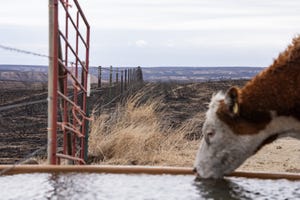A troubleshooting matrix for navigating through market woes
As farm debt continues to rise to historic levels, consider using this matrix to weather through tough economic challenges.
March 5, 2019

Throughout my career as an agricultural writer, I’ve covered the economic highs and lows experienced by food producers. As producers, we have collectively weathered through some seriously challenging times, but we have also celebrated some major victories, as well.
Where do producers sit financially right now? It depends on who you ask. Rumors at the cafe or grain elevator may reveal how your neighbors are doing. Perhaps more accurate than the local gossip, recent reports indicate soaring levels of debt held by America’s farmers and ranchers.
Speaking to the House Agriculture Committee recently, USDA Secretary Sonny Perdue said, “Farm debt has been rising more rapidly over the last five years, increasing by 30% since 2013 – up from $315 billion to $409 billion, according to USDA data, and up from $385 billion in just the last year – to levels seen in the 1980s.”
As reported by Reuters, Perdue added, “Relatively firm land values have kept farmer debt-to-asset levels low by historical standards at 13.5%, and continued low interest rates have kept the cost of borrowing relatively affordable. But those average values mask areas of greater vulnerability.”
The Trump administration pledged $12 billion in aid for farmers to counter the losses accrued from ongoing trade wars. Of that $12 billion, more than $8 billion has been paid out. However, farmers insist they want “trade not aid,” but that doesn’t negate the fact that many producers are struggling right now.
So how should producers weather the current financial hurricane? It’s time to reference the Troubleshooting Matrix, says David Kohl, a leading voice on agricultural lending and market trends.
In a recent article published by First Dakota National Bank, Kohl writes, “The agriculture economic reset is now entering its seventh year since the commodity super cycle years from 2007 to 2012. The dairy industry has taken the brunt of this economic punch, followed by grains and hogs, and to a much lesser extent, poultry and beef.
“An economic environment of low margins and high volatility has resulted in financial and emotional stress. A time-tested tool of the 1980s, called the ‘troubleshooting matrix,’ may be en vogue now as producers and lenders navigate the economic white waters in the short and long-term.”
If facing insufficient payment capacity, the troubleshooting matrix walks agricultural families through their options, which includes cutting business costs (feed and labor), increasing non-farm revenue and income, cutting living withdrawals, restructuring debt, capital infusion or bankruptcy.
Kohl says, “The troubleshooting matrix was designed and refined as the result of financial stress in the 1980s. This one-page process allows producers and lenders to think through options, similar to a quarterback going through progressions at the line of scrimmage as play conditions change. The troubleshooting matrix requires producers and lenders to explore other alternatives before implementing a refinance or restructure strategy.”
Kohl breaks down these options in the article and offers excellent strategies for each proposed avenue in the matrix.
For example, he asks farming and ranching families to look closely at their standard of living.
“Of course, the troubleshooting matrix option requires one to examine family living withdrawals. For the most accurate results, complete a diary of living expenses on a daily or weekly basis to determine where the cash flow leaks are occurring,” he writes.
“Once this is done, analyze the data and develop a monthly family living budget. It can be constructed and monitored just like farm cash flow budgets.
“Farm family living cost doubled from the go-go years of 2007 to 2012. The premise is the more you make, the more you spend. Another factor contributing to the increase in family living cost has been an increase in the number of generations or people living from the profits of a business,” he adds.
“One must make sure that everyone is pulling their weight in the business in this economic climate. Some businesses are experiencing stressed cash flow due to the high cost of adult care or healthcare, which can amount to $70,000 to $90,000 per year.”
Read the entire matrix and Kohl’s explanation of each path by clicking here. You may just find inspiration for ways to weather through tough times.
The opinions of Amanda Radke are not necessarily those of beefmagazine.com or Farm Progress.
About the Author(s)
You May Also Like



.png?width=300&auto=webp&quality=80&disable=upscale)

